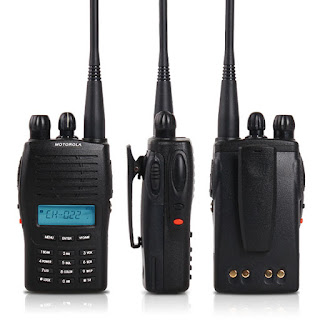FAKE!
 |
| This radio is fake! |
What do I mean by fake? This product uses the Motorola logo and/or name which is an infringement on the the trademark of Motorola Solutions. It could also be considered as fraud as the seller might be knowingly passing off these radios as the real McCoy.
So what's the big deal? Well, the MT-777 seems to be made in some, way below par, Chinese factory and somewhere along the way, gets a Motorola badge and finds its way into a Motorola branded box.
Why would anyone want to do this? The 山寨-branded MT-777 sells for around $30 whereas if one were to stick a Motorola badge on it and drop it into a Motorola box, one can ask >$90 for the same thing.
Why are these radios so cheap? The reasons are numerous: no R&D required, just copy-copy-copy; extremely low labour costs; cheap materials and components; no after-sales service needed hence no overhead; imported and sold by fly-by-night-traders; goods sold ex-works (importer usually pays freight and customs) etc.
Why should we be bothered? For the consumer (now I'm referring to end users with no industry-specific knowledge), there would be no way for them to reasonably tell the difference between a genuine product and a fake. Since radios like this are of such poor quality, the average failure rate must be 5-20 times greater than a genuine Motorola radio. Because there is no after-sales service, the consumer is often left high-and-dry with non-functional communications equipment and nobody to help them. These radios also probably present a safety risk.
Safety? For those of you living in one of the EEA countries (and Turkey), the radios do not meet the requirements to bear the CE mark. A product bearing the CE mark conforms with health, safety and environmental protection standards defined in the EU RED; RoHS2 and WEEE directives.
It works, why should I care about CE and RED? In Europe, that's the law.
Having a RED compliant radio communications product ensures that it wont interfere with another system (or services) and that other systems will not interfere with it.
A RoHS2 compliant product will not contain materials that could be dangerous to your health and the environment. WEEE ensures that when you part ways with your product, it can be safely dismantled and recycled.
I'm not in Europe? Radios like this probably also don't not meet FCC and other regulatory requirements either.
Yeah, these things are so damn cheap, if it breaks, why not just buy another one? Based on my own analysis and on user feedback, radios like these are really poorly made. I estimate the mean time between failures to be in the order of 15000 hours. So if you are using these radios 24-7 they will fail with the first two years of use (best case). So after two years you buy another one, and after the fifth year (which sort of the industry average for asset replacement) you've had to replace the radio three times. Don't forget about downtime.
By comparison, the entry-level Motorola DP1400 has a MTBF of around 100000 hours (five times longer than the 伪造) so you'd probably only have to replace the battery after 2-3 years. The radio will last for at least 5 years (ceteris paribus).
Here's the maths. I've used Euro for my figures:
- 山寨 MT-777 MTBF ≈ 15000 hours | ARP ≈ €155 | 5year total cost of ownership ≈ €455
- Motorola DP1400 MTBF ≈ 100000 hours | MSRP ≈ €180 | 5 year total cost of ownership ≈ €260
Radios like this are, in most cases shipped CPT or EXW, so the importer has to pay duties - in Germany this can amount to €36 if the shipment doesn't get stopped.
How do I make sure that whatever I get is genuine? Always buy from an authorized Motorola Channel Partner. If you are unsure about your purchase, contact Motorola. There is a rule that goes: if it's too good to be true it probably is.




Leave a Comment